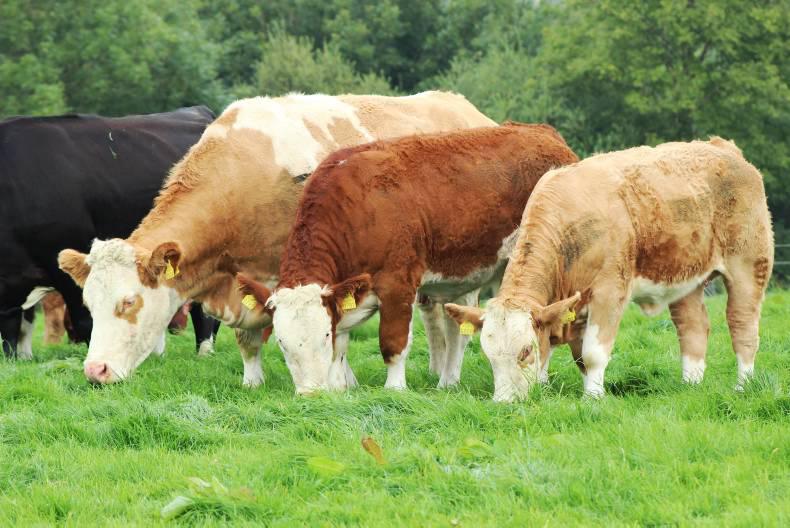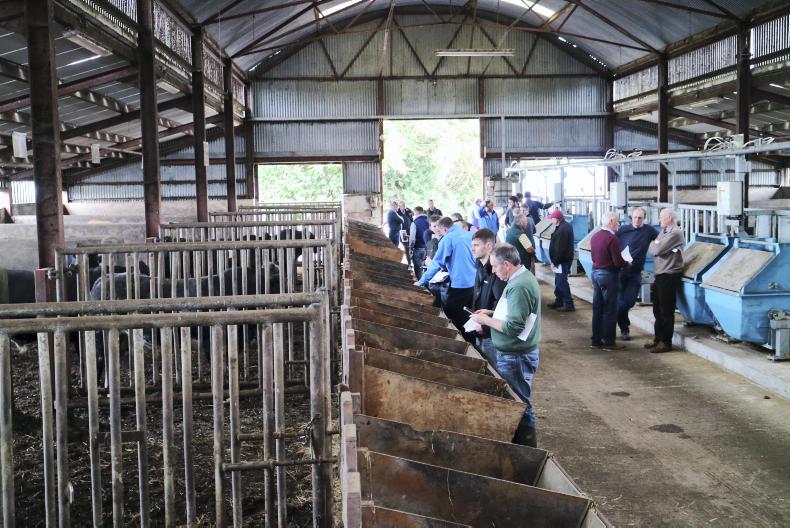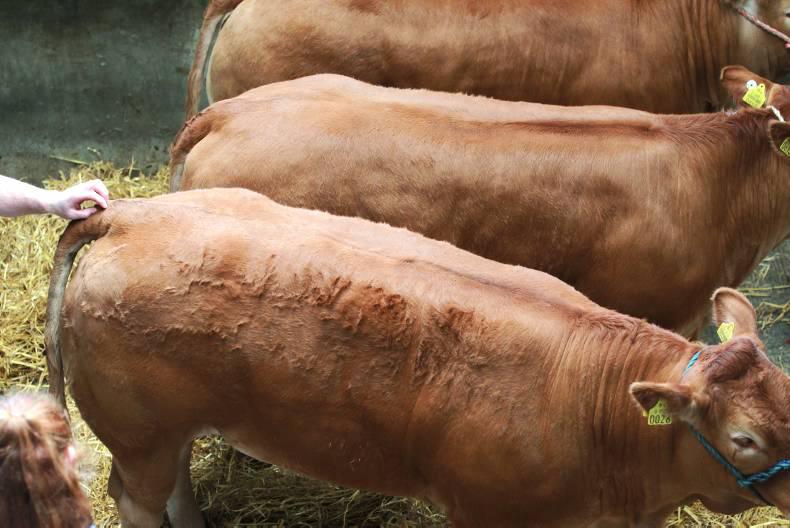High output per cow is the driving force behind suckler production. When we talk about high output per cow, optimal herd fertility, achieving targeted calf growth rates and high calf quality are the principal factors. However, in the Irish system, liveweight output from suckler beef herds is extremely low – gross output was only valued at €1,376/ha in 2012.
Therefore, if the through potential of the suckler herd is to be fully realised, this unacceptably low level of output must be addressed as it does not provide sufficient revenue to generate a sustainable income, regardless of the level of efficiency.
Stocking rate has a large impact, but there is also an opportunity on many farms to lift output per cow. For suckler cows, there are two elements to output. Firstly, each cow must produce a calf annually. Secondly, progeny must attain high levels of liveweight gain – most importantly in the pre-weaning period.
Leaving aside fertility issues, the liveweight performance of suckler-bred progeny must be increased (cost-effectively) to offset the cost of maintaining the dam.
There is strong evidence that performance is limited by declining milk yields in the national suckler beef herd.
The milk yield of the dam is the key driver of weaning weight and, consequently, carcase weight. Since progeny live or carcase weight is the most important output from suckler beef herds, it is critical that the weight of progeny at weaning is high.
On farms operating a two-year-old heifer calving system, milk yield of beef cows is central to adequate calf passive immunity via colostrum (first milk) and achieving the target weight at puberty, breeding and calving.
Optimum level of milk
Even when the genetic potential for high milk production is present within a cow or herd, it does not mean that this level of milk production will be achieved. Nutritional and environmental factors will affect the degree to which the genetic potential for milk production is expressed. These factors must be equally considered as they can affect calf weaning weights and cow reproductive rates.
In an Irish spring-calving scenario, the calf requirements and milk production are well matched on a grass diet. Optimum milk production to meet calf growth requirement (1.1kg-1.2 kg/day) is on average 9kg/day over the seven-month rearing period. After turnout to grass, ideally milk production peaks at 11kg/day and from mid-season onwards it declines to 6.6kg-7kg/day.
On many beef farms, cow milk yield is only at half (averaging 5.5-6.5 litres/day) the requirement, especially in the early stages of the rearing phase. Importantly, milk accounts for two-thirds of the pre-weaning gain of the spring-born calf and it is not until the third or fourth month that solid feed accounts for half the calf’s daily gain.
Cow breed comparisons
Sourcing cow replacements from within the suckler herd (rather than from the dairy herd), coupled with the national herd selection policy, has resulted in a reduction in the proportion of dairy ancestry in beef cows and, consequently, reduced milk yield and calf weaning weight.
Indeed, the breed comparison research work from Grange studies, where milk yield and weaning weight are routinely measured, indicates that progeny from half-bred Limousin X Friesian cows are on average 30kg-40kg heavier at 14 months than progeny of the other three-quarter-bred continental breed types.
The work also shows that the difference in weight at weaning will remain throughout the rest of the production cycle – there is no subsequent recovery in liveweight post-weaning. From an economic viewpoint, a 40kg heavier yearling roughly translates to an €80/head benefit or an additional €150 increase in output per hectare for a well-run intensive system.
National trends
Maternal weaning weight (daughter milk kg) is the trait in the ICBF evaluations, which describe the impact of suckler cow milk yield on weaning liveweight. Analysis from Andrew Cromie, ICBF, shows that over the last 20 years, for all of the main beef breeds, there has been a national downward trend for maternal milk – reflective of the increased emphasis placed on terminal traits in all breed improvement programmes.
In fact, Cromie’s analysis highlights the real danger that the improvements being achieved in growth genes for weaning weight are being wiped out by losses in milk genes in the daughter, resulting in no net gain.
However, significant variation within breeds is still present for maternal milk in the national database.
For instance, if we compare the level of genetic difference between the top-ranked (Angus) and bottom-ranked (Charolais) breeds for maternal milk, Charolais (17.8kg) have a higher breed difference within compared with Angus cattle (13.8 kg). This indicates that there are excellent maternal milk sires present in both breeds from which to select. But, relative to 20 years ago, the gene pool of true maternal bulls is diminishing rapidly.
Improving milk performance
The starting point is to benchmark where you currently stand. The best indicator is the weight-age target at weaning, taking account of breed type and age. Once you establish where your herd is, you can devise an improvement strategy.
First-cross Friesian/beef heifers from the dairy herd: This is an obvious choice if you are low on milk and need a large improvement of 50% (ie 4-5l). Introducing dairy genes is one of the only options to quickly correct this problem. Once you have a milk threshold in your herd, you can then use proven maternal sires and cross-breeding, if breeding within, to maintain this critically important trait and other desired cow traits. The option to breed up within the herd with maternal sires from a very low milk yield base is questionable. Introducing dairy genetics is a more long-term option and it is debatable whether the level of milk production gained from beef genetics, where milk is limited, would ever equal that achieved with the dairy cross.
For instance, the breed value (PTA) for milk from dairy-origin cows is 11.4, compared with four to eight for beef-cross cows.
The key issue in making this work is to try to source replacement heifers from dairy stock with good beef traits. Recently, beef breed societies (Angus, Hereford and Limousin) have put more effort into identifying and introducing sires with the traits of easy calving and short gestation, coupled with desired carcase traits to entice dairy farmers to use these sires and meet this growing marketplace.
Good maternal milk in your cows: The key here is to maintain a positive level of milk in your cows. Again, if breeding replacements from within the herd, it can combine a number of approaches. From experience with the Teagasc/Irish Farmers Journal BETTER Farm Beef Programme participants, the best results are achieved when sires are chosen from well-established maternal lines (eg Limousin – Ronick Hawk, Simmental – Seaview Tommy) and combined with a proven high maternal cow index proof (five-star points), with a strong focus in both cases on achieving a positive breeding value for maternal milk. For maternal milk, improvements do not rely solely on the maternal replacement index as milk traits only have a 13% weighting overall. Selection decisions should focus on finding an acceptable balance among milk production and other economically important traits.Supplement with meal: In respect of milk production traits, a short-term solution may be to adopt alternative weaning strategies involving alternative regimens, such as early weaning and/or creep-feeding of suckler beef cow progeny, especially export-potential animals. Creep-feeding can involve creep-grazing of suckled calves in paddocks, prior to the introduction of the cow herd, or creep-feeding of concentrates to the calf. In order to meet calf growth potential and weaning weight targets, creep-grazing and/or creep-feeding of concentrate to the calf can be used to compensate for a lack of milk. This should be viewed as a short-term solution, however, with the long-term aim of introducing more milk into the herd.
High output per cow is the driving force behind suckler production. When we talk about high output per cow, optimal herd fertility, achieving targeted calf growth rates and high calf quality are the principal factors. However, in the Irish system, liveweight output from suckler beef herds is extremely low – gross output was only valued at €1,376/ha in 2012.
Therefore, if the through potential of the suckler herd is to be fully realised, this unacceptably low level of output must be addressed as it does not provide sufficient revenue to generate a sustainable income, regardless of the level of efficiency.
Stocking rate has a large impact, but there is also an opportunity on many farms to lift output per cow. For suckler cows, there are two elements to output. Firstly, each cow must produce a calf annually. Secondly, progeny must attain high levels of liveweight gain – most importantly in the pre-weaning period.
Leaving aside fertility issues, the liveweight performance of suckler-bred progeny must be increased (cost-effectively) to offset the cost of maintaining the dam.
There is strong evidence that performance is limited by declining milk yields in the national suckler beef herd.
The milk yield of the dam is the key driver of weaning weight and, consequently, carcase weight. Since progeny live or carcase weight is the most important output from suckler beef herds, it is critical that the weight of progeny at weaning is high.
On farms operating a two-year-old heifer calving system, milk yield of beef cows is central to adequate calf passive immunity via colostrum (first milk) and achieving the target weight at puberty, breeding and calving.
Optimum level of milk
Even when the genetic potential for high milk production is present within a cow or herd, it does not mean that this level of milk production will be achieved. Nutritional and environmental factors will affect the degree to which the genetic potential for milk production is expressed. These factors must be equally considered as they can affect calf weaning weights and cow reproductive rates.
In an Irish spring-calving scenario, the calf requirements and milk production are well matched on a grass diet. Optimum milk production to meet calf growth requirement (1.1kg-1.2 kg/day) is on average 9kg/day over the seven-month rearing period. After turnout to grass, ideally milk production peaks at 11kg/day and from mid-season onwards it declines to 6.6kg-7kg/day.
On many beef farms, cow milk yield is only at half (averaging 5.5-6.5 litres/day) the requirement, especially in the early stages of the rearing phase. Importantly, milk accounts for two-thirds of the pre-weaning gain of the spring-born calf and it is not until the third or fourth month that solid feed accounts for half the calf’s daily gain.
Cow breed comparisons
Sourcing cow replacements from within the suckler herd (rather than from the dairy herd), coupled with the national herd selection policy, has resulted in a reduction in the proportion of dairy ancestry in beef cows and, consequently, reduced milk yield and calf weaning weight.
Indeed, the breed comparison research work from Grange studies, where milk yield and weaning weight are routinely measured, indicates that progeny from half-bred Limousin X Friesian cows are on average 30kg-40kg heavier at 14 months than progeny of the other three-quarter-bred continental breed types.
The work also shows that the difference in weight at weaning will remain throughout the rest of the production cycle – there is no subsequent recovery in liveweight post-weaning. From an economic viewpoint, a 40kg heavier yearling roughly translates to an €80/head benefit or an additional €150 increase in output per hectare for a well-run intensive system.
National trends
Maternal weaning weight (daughter milk kg) is the trait in the ICBF evaluations, which describe the impact of suckler cow milk yield on weaning liveweight. Analysis from Andrew Cromie, ICBF, shows that over the last 20 years, for all of the main beef breeds, there has been a national downward trend for maternal milk – reflective of the increased emphasis placed on terminal traits in all breed improvement programmes.
In fact, Cromie’s analysis highlights the real danger that the improvements being achieved in growth genes for weaning weight are being wiped out by losses in milk genes in the daughter, resulting in no net gain.
However, significant variation within breeds is still present for maternal milk in the national database.
For instance, if we compare the level of genetic difference between the top-ranked (Angus) and bottom-ranked (Charolais) breeds for maternal milk, Charolais (17.8kg) have a higher breed difference within compared with Angus cattle (13.8 kg). This indicates that there are excellent maternal milk sires present in both breeds from which to select. But, relative to 20 years ago, the gene pool of true maternal bulls is diminishing rapidly.
Improving milk performance
The starting point is to benchmark where you currently stand. The best indicator is the weight-age target at weaning, taking account of breed type and age. Once you establish where your herd is, you can devise an improvement strategy.
First-cross Friesian/beef heifers from the dairy herd: This is an obvious choice if you are low on milk and need a large improvement of 50% (ie 4-5l). Introducing dairy genes is one of the only options to quickly correct this problem. Once you have a milk threshold in your herd, you can then use proven maternal sires and cross-breeding, if breeding within, to maintain this critically important trait and other desired cow traits. The option to breed up within the herd with maternal sires from a very low milk yield base is questionable. Introducing dairy genetics is a more long-term option and it is debatable whether the level of milk production gained from beef genetics, where milk is limited, would ever equal that achieved with the dairy cross.
For instance, the breed value (PTA) for milk from dairy-origin cows is 11.4, compared with four to eight for beef-cross cows.
The key issue in making this work is to try to source replacement heifers from dairy stock with good beef traits. Recently, beef breed societies (Angus, Hereford and Limousin) have put more effort into identifying and introducing sires with the traits of easy calving and short gestation, coupled with desired carcase traits to entice dairy farmers to use these sires and meet this growing marketplace.
Good maternal milk in your cows: The key here is to maintain a positive level of milk in your cows. Again, if breeding replacements from within the herd, it can combine a number of approaches. From experience with the Teagasc/Irish Farmers Journal BETTER Farm Beef Programme participants, the best results are achieved when sires are chosen from well-established maternal lines (eg Limousin – Ronick Hawk, Simmental – Seaview Tommy) and combined with a proven high maternal cow index proof (five-star points), with a strong focus in both cases on achieving a positive breeding value for maternal milk. For maternal milk, improvements do not rely solely on the maternal replacement index as milk traits only have a 13% weighting overall. Selection decisions should focus on finding an acceptable balance among milk production and other economically important traits.Supplement with meal: In respect of milk production traits, a short-term solution may be to adopt alternative weaning strategies involving alternative regimens, such as early weaning and/or creep-feeding of suckler beef cow progeny, especially export-potential animals. Creep-feeding can involve creep-grazing of suckled calves in paddocks, prior to the introduction of the cow herd, or creep-feeding of concentrates to the calf. In order to meet calf growth potential and weaning weight targets, creep-grazing and/or creep-feeding of concentrate to the calf can be used to compensate for a lack of milk. This should be viewed as a short-term solution, however, with the long-term aim of introducing more milk into the herd.










SHARING OPTIONS